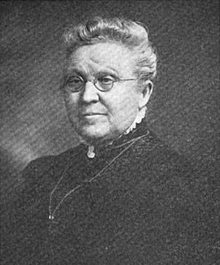- Mary Collins (missionary)
-
Mary Collins (April 18, 1846 - May 25, 1920) was a missionary, writer, and proponent for Native American rights in the Dakota Territory of the United States of America. She was a prolific member of the American Missionary Association, having spent thirty-five years of her life living amongst the Sioux tribe acting as a teacher, translator, and diplomat between the Sioux and white settlers. She was a noted friend and correspondent of Sitting Bull, one of the most famous Native Americans in United States history. Despite her actions and life-long commitment to peaceful relations with the Sioux, Collins is a relatively unknown character in American History.
Contents
Early life
Mary was born in 1846 to Ephraim and Margaret Collins, in the town of Upper Alton, Illinois. Her father, a northerner and her mother, a southerner, both were children of Revolutionary War veterans. She credits her ancestry, along with the physical training of her brothers, with providing her with the "pioneer spirit" that came to define her life. At the age of two, Collins and her family moved to Keokuk, Iowa, a small town in the southeastern part of the state known for its neutrality between White and Native settlers. It was here that she would attend a mix of public and private schools on her way to receiving a Master of Arts from Ripon College in Wisconsin. Her religious training and interest in missionary work began at an early age, when she began attending church and Sabbath School. In her publication How I Became A Missionary, Collins states that she was introduced to, and trained for her future calling by her Sabbath school teacher. Physical preparations for Collins came in the form of horse riding, boating, tree-climbing, and weight lifting alongside her brothers.
Life with the Sioux
Collins was first called to missionary work in 1875 by the American Board of Commissioners for Foreign Missions. She wished to work in the Micronesia island territories in the western Pacific Ocean, but she failed to pass the required medical exam due to a lung condition. She was asked instead to serve as a missionary to the Native Americans in the Dakota territory, arriving at her post on November 10, 1875. Collins was quick to adapt to the language, claiming she had no trouble in seeing the Native American side of any question. She enjoyed a relatively high status amongst the tribe due to her knowledge of medicine, which allotted her privileges that were not typically allowed. She was also a source of counsel and knowledge on domestic affairs, religious problems, and legal questions. During her time on the Reservation, she also served as a lecturer on behalf of the Native American way of life at universities, public schools, churches, and conferences.
Friendship with Sitting Bull
Sitting Bull, the tribal chief of the Lakota Sioux at the end of the 19th century, was introduced to Mary Collins sometime in 1885; four years after his defeat at The Battle of Little Bighorn. She impressed him almost immediately with her command of the Lakota language, and for this, he considered her a relative. American Historian and biographer Stanley Vestal states in his biography Sitting Bull: Champion of the Sioux that Mary Collins "knew him better than almost any other white person at the agency." Her close relationship with Sitting Bull, along with her quest for peaceful cooperation between both Natives and the expanding white settlements, led her to request Sitting Bull to stop encouraging the Ghost Dance amongst his people. This dance was seen as a threat by U.S. Army troops and policemen sent to the Dakota region. Sitting Bull and his tribe persisted, and on December 15, 1890, Sitting Bull was arrested, and subsequently shot and killed in the ensuing mayhem.
Death and legacy
In 1910, due to her failing strength, Mary Collins gave up her work in the field with the Sioux. She returned to Keokuk, Illinois to live with sister. From there, she continued to be an active member of the American Missionary Association. There is no evidence of Mary Collins ever marrying. Illness set in during the early summer of 1919, which confined Collins to her bed until her passing in 1920. Her writings, many of them in the Dakota language, remained an important part of the Dakota culture long after her death. Dr. Frank White, a representative of the American Missionary Association, paid tribute to her life by characterizing her as "pioneer in the nth power." Many of her correspondences, including her own autobiography and will, are held in the South Dakota State Historical Society.
References
http://history.sd.gov/Archives/Data/manuscript/collins.aspx
http://books.google.com/books/about/South_Dakota_historical_collections.html?id=xuAUAAAAYAAJ
Vestal, Stanley. Sitting Bull: Champion of the Sioux: A Biography. University of Oklahoma Press, 1957.
Categories:- 1846 births
- 1920 deaths
- American missionaries
Wikimedia Foundation. 2010.

